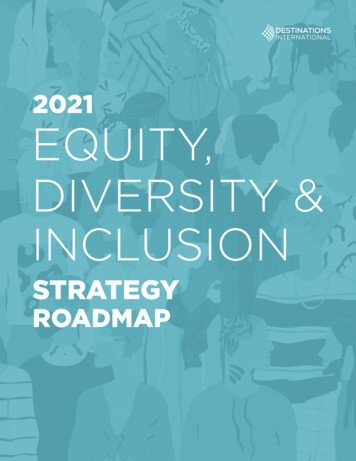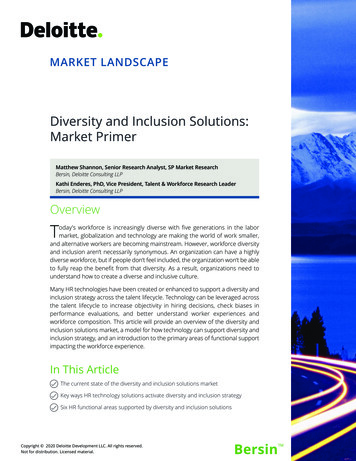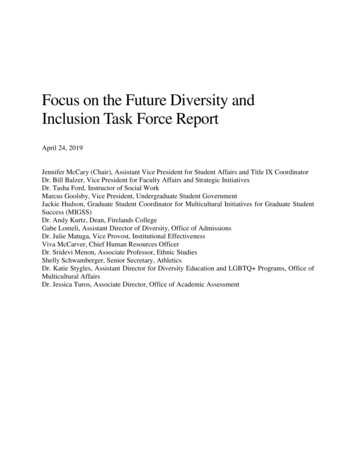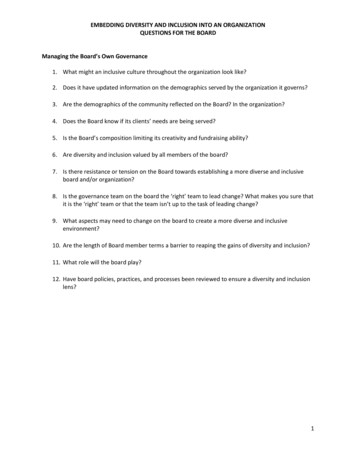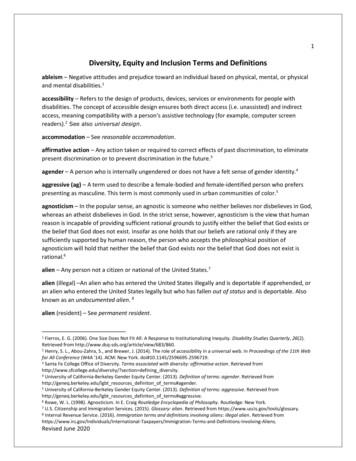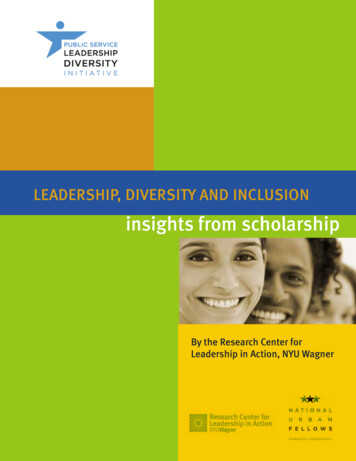
Transcription
LEADERSHIP, DIVERSITY AND INCLUSIONinsights from scholarshipBy the Research Center forLeadership in Action, NYU Wagner1Leadership, Diversity and Inclusion: Insights from Scholarship
Leadership, Diversity and Inclusion: Insights from Scholarship reports on a2010 project developed at the Research Center for Leadership in Action at NewYork University’s Robert F. Wagner Graduate School of Public Service, in supportof the National Urban Fellows Public Service Leadership Diversity Initiative.The research team, under the direction of Professor Sonia Ospina, PhD,consisted of Waad El Hadidy and Grisel Caicedo, with support from AmandaJones. A second report, Advancing Diversity in Public Service: A Review ofLeadership Development Programs in the US, complements this work. BethanyGodsoe contributed to the conceptualization of the overall project.AcknowledgmentsThe Research Center for Leadership in Action would like to extend a special thanks to Paula Gavin, DavidMensah, Mohamed Soliman and the staff at the National Urban Fellows who collaborated with us inthis project. Thanks to our colleague Erica Gabrielle Foldy, PhD, for her deep insight and expertise in theliterature on diversity.It is with gratitude that National Urban Fellows acknowledges the generous support from the W.K. KelloggFoundation, John S. and James L. Knight Foundation and JP Morgan Chase that made this Public ServiceLeadership Diversity research possible. It is our sincere expectation that the Public Service LeadershipDiversity movement will enhance and empower the lives of people of color to become the leaders andchange agents of our country’s present and future. Copyright Research Center for Leadership in Action, March 2011Design and Layout by Kathryn Bowser2Leadership, Diversity and Inclusion: Insights from Scholarship
About the National Urban FellowsNational Urban Fellows seeks to inspire excellence and diversity in public service leadership.Founded in 1969 to counter the under-representation of people of color and womenin leadership, National Urban Fellows is one of the oldest leadership developmentorganizations in the United States, and a premier voice of authority on leadership diversityfor public, private and nonprofit sectors.The organization’s range of mid-career leadership development programs includes: the 40-year-oldMPA Fellowship, a 14-month program linking graduate-level academic training with a critical leadershipexperience in a large nonprofit or government agency; an alumni program offering life-long networking,career enhancement and personal development opportunities; and America’s Leaders of Change, a careeracceleration program for leaders on the rise in government, nonprofit and private sectors.Today, together with its fellows, alumni, mentors and community leaders across the country, NationalUrban Fellows is making an impact on social justice and equity, by identifying issues, shaping solutionsand forming equitable public policies.National Urban Fellows develops the leadership for a changing America.Learn more at www.nuf.org.About the Research Center for Leadership in Actionat NYU WagnerThe Research Center for Leadership in Action (RCLA) is a research center at New York University’sRobert F. Wagner Graduate School of Public Service, a nationally top-ranked school for public affairs.RCLA’s research complies with the highest academic standards while at the same resonating with bothpractitioners interested in learning about leadership practice and scholars interested in developingtheories of leadership. Our research is done in partnership with leaders rather than on leaders to uncoverand cultivate insights that describe leadership clearly and with an authentic voice.RCLA has a long-standing commitment to research that supports diverse leadership at all levels oforganizations and across all sectors for the common good. Examples of our recent work include a studyexploring the relationship between race and leadership in social change organizations. In another study,RCLA scholars catalogue how “race-ethnicity” is treated in the leadership literature and present anintegrative framework for understanding the relationship between race and leadership. In a report basedon an RCLA-facilitated action learning inquiry, leaders of color committed to social justice offer strategiesfor community-based leaders of color to maintain the integrity of their work and remain accountable tocommunities, develop supportive relationships, deepen their understanding of race and educate others,and nurture new leaders. This research is part of RCLA’s work to support leadership that taps the resourcesof many voices to make systems and organizations effective, transparent, inclusive and fair.Learn more at www.wagner.nyu.edu/leadership.3Leadership, Diversity and Inclusion: Insights from Scholarship
About the National Urban FellowsPublic Service Leadership Diversity InitiativeAmerica was founded on the principles of justice, equality and inclusion. As a nation, we continue to strivefor full participation and equality for all citizens, upon whose shoulders the responsibility for upholdingthese principles rests. America is a multicultural society dedicated to inclusive participation in our democracy, and our laws and social policies have evolved over time to reflect this commitment.National Urban Fellows endeavors to build upon the diversity of our citizens to embrace the fullness of ourdemocracy, and in doing so we advance inclusion as both a moral imperative and an excellent businessmodel. The public service sector—from government and academic think tanks to foundations and nonprofitorganizations—must be inclusive if we are to develop fair and effective structures to fulfill the intention ofour democracy. This can be accomplished through removing cultural and structural barriers and eliminatingindividual acts of discrimination or bias.Though growing in population, people of color remain underrepresented in the leadership of the public service sector, an issue that can and must be resolved if we are to effectively change our nation’s most pressingsocial issues—from education to health, environment and justice. Our country is now composed of one-third,or 34 percent, people of color—a population that will grow to 54 percent by 2042. However, federal government leadership is only 16 percent people of color. On the state level only 15 percent people of color holdstatewide elective executive positions across the country. Moreover, only 18 percent of nonprofit leadershippositions are filled by people of color, and only 17 percent of foundation executives are people of color.When current disparities in public service leadership are addressed, the public service sector will havegreater ability and appeal to people of color with the leadership skills to solve social policy dilemmas. Theparticipation of people of color and the infusion of diverse voices and experiences into decision-makingprocesses ensure a sense of cultural competency and effectiveness within policy-based solutions to socialissues. As champions of transformational change, our goal is to not only achieve proportional representation in the public service sector by building a pipeline of talented, highly skilled candidates of color, butalso to dismantle the barriers to inclusion of people of color in leadership positions and to support the notion that diversity in leadership leads to organizational excellence.The National Urban Fellows Public Service Leadership Diversity Initiative inspires and advocates for excellence and diversity in public service leadership for America. With a dual emphasis on individuals andsystems, and through research, communications, stakeholder mobilization and action, the Public ServiceLeadership Diversity Initiative will develop a new, inclusive paradigm of public service leadership.SOURCES:US Census Bureau. (2008).Congressional Research Service. (2008). Membership of the 111th Congress: A Profile.CompassPoint Nonprofit Services. (2006). Daring to Lead, 25.TheAnnie E. Casey Foundation. (2004). Change Ahead: The 2004 Nonprofit Executive Leadership and Transitions Survey, 2.4Leadership, Diversity and Inclusion: Insights from Scholarship
TABLE OFCONTENTSOverview2Highlights of Findings3Methodology4Discussion of Findings: Insights from Scholarship51. Organizational Level: Frameworks and Perspectives on DiversityHow do organizations approach diversity?Diversity as Representative BureaucracyMultiple Organizational Perspectives on DiversityDiversity as InclusionSummary: Organizational-Level Implications for Leadership Diversity6679112. Individual Level: Human Interactions under Conditions of (Racial) DifferenceHow do individuals experience diversity and relate to each other?The Impacts of Diversity on Group Dynamics and LeadershipCultural Competence/IntelligenceSummary: Individual-Level Implications for Leadership Diversity123. Program Level: Describing and Assessing Diversity Management ProgramsHow do organizations “do” diversity management?The Impacts of Diversity Programs on OrganizationsManaging and Leveraging DiversitySummary: Program-Level Implications for Leadership Diversity18ConclusionsCommentary: Convergences, Divergences and Gaps in the LiteratureProspects for Research252729References1. Organizational Level: Frameworks and Perspectives on DiversityHow do organizations approach diversity?2. Individual Level: Human Interactions under Conditions of (Racial) DifferenceHow do individuals experience diversity and relate to each other?3. Program Level: Describing and Assessing Diversity Management ProgramsHow do organizations “do” diversity management?3131Appendix I - MethodologyAnalysis of Literature Reviewed38391Leadership, Diversity and Inclusion: Insights from Scholarship1215171820243336
OverviewDespite many years of efforts to diversify organizations, people of color remain significantlyunderrepresented in public service leadership positions. This results partly from structural barriers thathinder the professional advancement of people of color and partly from organizations’ varying successwith diversity efforts. That people of color are not well represented in positions of power is also a reflectionof a dominant leadership paradigm in which the experience of diverse leaders is largely marginalized.The National Urban Fellows (NUF) convened a series of national and regional leadership diversity summitsduring its 40th anniversary year, with the goal of shifting the national leadership paradigm to includeleadership models found in diverse communities, to embrace collective approaches and to define a newinstitutional diversity standard. Based on feedback from these summits, NUF is advancing the PublicService Leadership Diversity Initiative, a collaborative network and campaign action plan to inspireexcellence and diversity in public service leadershipThe goal at the Research Center forLeadership in Action (RCLA) at NYU Wagneris to develop knowledge and capacity forleadership at all levels of organizations andacross diverse sectors of society. Given thisclose alignment in goals, RCLA and NUF areworking together to further the diversityagenda.One of the first steps in this endeavorhas been a review of the latest scholarlythinking about leadership diversity inthe United States, with a focus on publicservice. The goal of this review is toestablish a broad and shared knowledgeof the latest thinking about leadershipdiversity; establish solid theoreticalgrounding for the NUF initiative; andproduce actionable recommendations forpublic service leadership development programs, advocates concerned with diversity issues, and publicand nonprofit institutions seeking to build leadership diversity within their organizations.The review of the scholarly literature is structured as follows. First we present highlights of the mainfindings from the literature and a brief explanation of the methodology (for full details please seeAppendix I). Then the various findings and literature categories are discussed in depth. Finally we presentconclusions, key convergences and divergences, and gaps found in the literature. The full set of references,organized by category, is the last section in the document, followed by the Methodological Appendix.2Leadership, Diversity and Inclusion: Insights from Scholarship
HIGHLIGHTSOF FINDINGSThe following is a brief summary of the keyfindings. These are revisited in more depth in theconclusions section.more integrated system, more commitment fromleadership, more holistic approaches—all of whichare largely untested.Mixed empirical works: There is a recognizedneed to do more empirical work, especially tounpack how efforts to foster diversity impact theorganization and its members. The empirical datathat do exist are mixed. Some studies have foundpositive correlations between increased diversityand bottom-line results, others have foundnegative correlations, and yet others have foundcombinations of positive and negative impacts.Equipping people AND organizations: Trendsin the literature are pointing to the need topay attention both to people of color and theorganizations where they work. Despite theirleadership acumen, people of color will stillencounter different ceilings if their organizationsand systems do not welcome their contributions.There is no one-size-fits-all: What the mixedresults suggest is that organizations are strugglingto deal with or leverage diversity without anyassurances of positive outcomes. There is no onesize that fits all—doing diversity well is preciselythe complex kind of work that requires leadershiprather than management solutions.Shifting landscape of terms: Scholars seemto be anxious about presenting the next silverbullet, as reflected in the shifting landscape ofterms. Scholars argue that what has been tried byorganizations is not enough—what is needed is aDiversity as a testament to organizationaladaptability: More recent literature is calling fora shifting of the case of diversity from a marketimperative to an understanding that racial diversityis only one reflection of the increasingly complexenvironment in which organizations need tooperate. The argument is that diversity presentsan opportunity for an organization to practicethe skills needed to deal with rapid change anddiversity on all fronts—not just race.Some progress in diversity, but not in leadership:There is some evidence that both public agenciesand the private sector are embarking on diversityinitiatives. Although anecdotal, pundits haveclaimed that leadership in thenonprofit sector is more diversethan in the for-profit world. Yet morecomprehensive research is neededto confirm this, and generally theresearch has tended to focus less onleadership and more on workforces.Nonprofit research largely missing:It is quite a surprise that there is verylittle research about leaders of colorin the nonprofit world or what kindsof initiatives nonprofit institutionsare taking to enhance diversity.Although still limited, there is muchmore documentation of diversitywithin the public and businesssectors.3Leadership, Diversity and Inclusion: Insights from Scholarship
METHODOLOGYRCLA’s task was to review the latest scholarlythinking on diversity, race and leadership inthe United States. Rather than dwelling on thedemographic changes or workforce inequities—realities that have been well documented—wefocused on the organizational and managementliterature with the objective of lifting practicalimplications for the NUF campaign.After a broad scan of potential references,having screened out those deemed irrelevantfor the project, we settled for a full review of85 references, 73 of which are academic, i.e.published in academic journals. We also included12 non-academic references because they havecontributed to heightened awareness aboutdiversity, particularly in the nonprofit sector. Of thereferences that address a specific sector explicitly,there was a balanced distribution between thosethat examined diversity in the public sector andthose that looked into the private sector. Onlysix of the 85 referenced address diversity in thenonprofit sector and of those, only one was anacademic reference, pointing to a serious dearth inthe nonprofit scholarly literature. In order to reacha critical mass of references, we decided to includework from the private sector. This is also logicalgiven that the diversity conversation draws on thebusiness literature.As a review of the latest thinking in diversityand leadership, we excluded any literature thatpredates the year 2000, with only a couple ofexceptions. It is also important to note thatleadership is rarely addressed as an explicitconstruct in the diversity literature. We bring ourunderstanding of leadership in order to draw outimplications for leaders of color or for influentialstakeholders concerned with racial justice. Formore details on methodology, please see Appendix I.4Leadership, Diversity and Inclusion: Insights from Scholarship
discussions of findings:insights from scholarshipScholarly work can be clustered around the following three broad categories. These correspond to differentlevels at which diversity is addressed or practiced. Each group includes research findings derived fromstudies addressing dimensions of a broad question, as follows:1. Organizational Level: Frameworks and Perspectives on Diversity - How do organizations approachdiversity?2. Individual Level: Human Interactions under Conditions of (Racial) Difference - How do individualsexperience diversity and relate to each other under conditions of racial difference?3. Program Level: Diversity Management Programs - How do organizations “do” diversity managementand what are their outcomes?What follows is a discussion of the findings for each main category. A note on how to read these findingsis pertinent: while the majority of literature reviewed is academic, we have extracted the most practicalelements for a practitioner audience. The discussion of each category starts with an explanation ofwhat the large category entails followed by a discussion of each respective subcategory. The italicizedsubheadings pull out notable concepts or insights from the literature.We provide illustrative references within each section. While we reviewed 85 references, we only cite thosethat are considered seminal, are regularly cited in the literature or present an argument directly relevant tothe NUF campaign. We offer implications for leadership diversity at the end of each section.The diagram below presents each category, its subcategories and the distribution of references found. Thatthe majority of articles fall in the “diversity management” category is not surprising, given the bias of theorganization and management field toward generating practice-grounded knowledge.Table 1:overview offindingsRace, Leadership and Diversity literature(85 references)1. Organizational Level - Frameworks and Perspectives: (24 references) 1.1. Diversity as representative bureaucracy 1.2. Multiple organizational perspectives on diversity 1.3. Diversity as inclusion2. Individual Level - Human Interactions and Relations: (24 references) 2.1. The impact of diversity on group dynamics and leadership 2.2. Cultural competence/intelligence3. Program Level - Diversity Management Programs and their Outcomes:(37 references) 3.1. The impacts of diversity programs on organizations 3.2. Managing and leveraging diversity5Leadership, Diversity and Inclusion: Insights from Scholarship
ORGANIZATIONAL LEVEL1Organizational Level: Frameworks and Perspectives on Diversity– How do organizations approach diversity?The first main category of the literature documentsthe different ways scholars have found thatorganizations approach and deal with diversity.These big picture paradigms are documentedhere. With the exception of the “representativebureaucracy” framework that is specific to thepublic sector, the subcategories below reviewboth private sector and public service contexts.Literature in this category addresses the questions:What are some of the main organizationalframeworks for thinking about and addressingdiversity and what are their inherent assumptions?Insights to these questions are found withinbodies of work about representative bureaucracy,multiple organizational perspectives on diversityand the paradigm of inclusion.Diversity as Representative BureaucracyAn often-cited study by Riccucci (2009) finds thatdespite continued calls for equity, white womenand people of color remain in lower-level, lowerpaying, and less prestigious jobs in non-postalfederal government jobs. White women havemade some progress in terms of reaching higherlevel positions, but their pay continues to lagbehind white as well as Asian men. Yet in lookingat general levels in the workforce, a plethora ofrepresentative bureaucracy studies have illustratedthat white women and people of color holdgovernment jobs at the federal, state and locallevels in equal and sometimes greater proportionsthan their concentration in the general population.The study asserts that a key question in assessingequity within government is the extent to whichleadership positions are equally distributedamong members of different groups for effectivedemocratic governance.This body of work looks at public sector agenciesas “representative bureaucracies,” a notion thatreflects the original intent of affirmative actionin public organizations (Pitts and Wise, 2010;Lim, 2006). The rationale for a representativebureaucracy is that “passive representation”—theextent to which a bureaucracy employs people ofdiverse social backgrounds, will lead to “activerepresentation”—the pursuit of policies reflectingthe interests and desires of those people (Riccucciand Meyers, 2004; Pitts, 2005).Harris (2009) corroborates the findings that yes,affirmative action has been effective in improvingthe employment status of women and minorities,especially in the public sector, yet the benefitshave been uneven. Generally, the glass ceilinghas made it harder for women to reach leadershippositions across the board. More specifically,nonfederal contractors and academia haveseen fewer employment gains for women. Wagedisparities by both race and gender still remain.These studies show that while there has been an6Leadership, Diversity and Inclusion: Insights from Scholarship
ORGANIZATIONAL LEVELimprovement in workforce diversity, diversity inleadership positions in the public sector is yet tobe attained.A few studies included here look at the efforts ofpublic organizations to attract a diverse pool ofapplicants. These offer insights for how publicorganizations can address recruitment strategies,which is one of the first steps in advancingrepresentativeness.A study of the New York State Department ofEducation (NYSDE) (Rangarajan and Black,2007) identifies several organizational barriersto advancing diversity and touches on theorganization’s networks for recruitment. This isinteresting given that networks have traditionallybeen treated by scholars as belonging to theindividual. Among other barriers, Rangarajanand Black find that the insular perspectives ofmanagers and prevalence of old-boy networksperpetuate existing configurations of NYSDEemployee profiles and impede diversity.Rubaii-Barrett and Wise (2007) conduct a reviewof diversity messages on 50 state government Websites and suggest the need for greater emphasison the Internet as a recruiting tool. They find thata majority of states do not demonstrate a clearcommitment to diversity on their Web sites, whichmay be a deterrent to applicants of color or anyonewho seeks to work in a diverse environment (Ng &Burke, 2005).Multiple Organizational Perspectiveson DiversityApart from the literature on representativebureaucracy that is specific to the public sector,scholars have attempted to understand theinstitutional mindsets from which organizationsapproach and address diversity. Severalorganizational paradigms are documented here,7Leadership, Diversity and Inclusion: Insights from Scholarshipas well as their influences on team functioning andthe experiences of team members.The Spectrum of OrganizationalPerspectives on DiversityA seminal article by Ely and Thomas (2001)identifies three perspectives based on qualitativeresearch conductedin three culturallydiverse private sectororganizations: theintegration-and-learning(IL) perspective, theaccess-and-legitimacy(AL) perspective, andthe discrimination-andfairness (DF) perspective.The perspective ondiversity a work groupheld influenced howpeople expressed andmanaged tensions relatedto diversity, whether thosewho had been traditionallyunderrepresented inthe organization feltrespected and valued by their colleagues, andhow people interpreted the meaning of their racialidentity at work. We explain each in what followsbecause these perspectives have been the subjectof much scholarly work.In IL, cultural diversity is viewed as a potentiallyvaluable resource that the organization canuse, not only at its margins to gain entree intopreviously inaccessible niche markets, but at itscore to rethink and reconfigure its primary tasks.Where this perspective is applied, group membersare encouraged to discuss openly their differentpoints of view because differences, includingthose explicitly linked to cultural experience, werevalued as opportunities for learning.
ORGANIZATIONAL LEVELWhile there have been stridesin workforce numbers, the truetest of democratic governanceand an organization’sability to reap the benefitsof diversity depends on theextent to which its leadership,not only its staff, is diverse.In AL, cultural diversity is a potentially valuableresource, but only at the organization’s marginsand only to gain access to and legitimacy with adiverse market. Embracing this perspective in thework groups studied led to race-based staffingpatterns that matched the racial make-up ofthe markets they served. This mindset fosteredperceptions of inequity related to staff functions;racially segregated career tracks and opportunities,which fostered concerns among staff of colorabout the degree to which they were valued andrespected; and ambivalence on the part of peopleof color about the meaning and significance oftheir racial identity at work.In DF, cultural diversity is a mechanism forensuring equal opportunity, fair treatment and anend to discrimination. Where this perspective is atwork, there is no articulation of the link betweencultural diversity and the group’s work and, in fact,this perspective espouses a color-blind strategy formanaging employees and employee relations. Inwork groups subscribing to this view, employees8Leadership, Diversity and Inclusion: Insights from Scholarshipnegotiated the meaning of all race-relateddifferences on moral grounds. Questions andconcerns about fairness led inevitably to strainedrace relations characterized by competing claims ofinnocence, with each group assuming a defensiveposture in relation to the other. Racial identity thusbecame a source of apprehension for white peopleand feelings of powerlessness for many people ofcolor.This work, like others we review in othercategories, presents a spectrum on thinking aboutdiversity, with one end—the IL perspective—beingclearly more holistic and considerate of creating atruly diverse organization than a perspective thatis based on legalistic notions.An article by Selden & Selden (2001) uses thethree perspectives found by Ely and Thomasto consider their relevance and application topublic organizations. For agencies adopting theDF perspective the authors argue that the centralquestion of interest is the extent to which theagency reflects the demographic origins of society.A primary concern, of course, is the determinationof which demographic characteristics are mostimportant to public organizations. In the publicsector, this view is closest to the notion ofrepresentative bureaucracy discussed earlier.Work on AL in the public sector is concernedwith the relationship between employment ofminorities and women and agency outputs andoutcomes affecting these groups. The authorsclaim that regarding IL, relatively little researchhas explored the impact of diversity on internalpublic sector operations. Yet a number of agencieshave adopted diversity training in an effort to takeadvantage of the perceived benefits.Selden & Selden propose a fourth paradigm:valuing-and-integrating, which seeks to create amulticultural climate by incorporating individuals’pluralistic views. Diversity is often discussed atthe organizational level, as in the Ely and Thomaswork. Selden & Selden’s valuing-and-integrating
ORGANIZATIONAL LEVELmodel proposes that one needs to understanddiversity from an individualistic perspective beforeviewing the aggregate organization. A diversifiedorganization is founded, by its very nature, onthe fabric of cultures that each person offers andadds to the collective working environment. Thus,this paradigm suggests that an organization’sculture is continually influenced by the individualcultures of its members. Employees will be moreinvolved and committed to their employer whentheir worldviews are reflected in the organization’sstrategy to implement its mission and vision.The notion of paying attention to each individualversus the whole organization in abstract comesup in other literature below.there is no truly ideal form for treating diversity – allapproaches have been documented to yield bothpositive and negative outcomes (see page 18).For organizational initiatives working to promotediversity, it is also important to diagnose wherethe organization falls on the spectrum presentedabove versus where it wants to be. For instance,if an organization is adopting a “discriminationand fairness” perspective, and the objective is tobecome a “valuing and integrating” organization,quite a radical shift in culture and policies wouldbe required
in leadership, National Urban Fellows is one of the oldest leadership development organizations in the United States, and a premier voice of authority on leadership diversity for public, private and nonprofit sectors. The organization's range of mid-career leadership development programs includes: the 40-year-old

